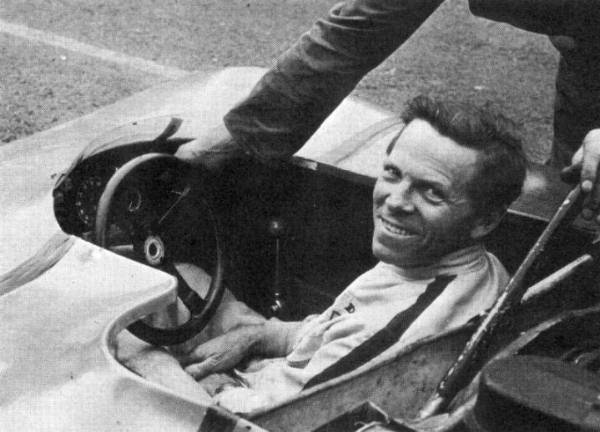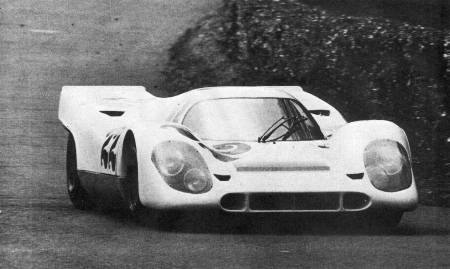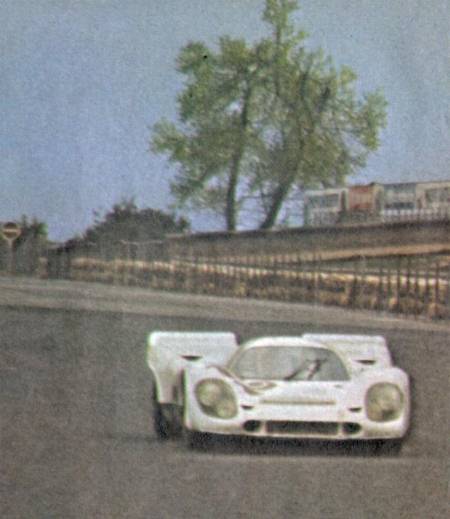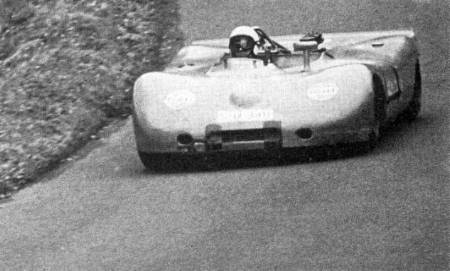|
CONTINENTAL
DIARY
"
The car literally leapt forward and it immediately became urgent to change up
into 3rd (all in the
time it took you to read the first three words of this sentence)."
Paul
Frère drives Porsche's 917 (0-100 mph in 5.3 sec.) and the 908/03.

I
shall not make any excuse for again having Porsche as the main subject of a
Diary, for having a go at the latest 917 and the as yet unraced new 908/03 on
the Nürburgring is an experience I just cannot wait to put into writing.
It
all came about because I was unable to attend the Porsche Press conference at
Hockenheim last December, when a few journalists were allowed to drive the World
Championship winning 908 model. To make up for the loss I was invited to drive
the latest cars at a testing session. So I drove to the Nürburgring where a 917
with the latest wedge-shaped body and two well worn 908/03s--the first
experimental prototypes, as yet unraced, of the successor to last year's 908/02
spyder-were undergoing development tests before the Monza 1000 Kilometre Race
and the Targa Florio.
For
these tests the South Loop of the Nürburgring had been hired for four days. Not
much work had been done before I arrived on the evening before the third day. As
most readers are surely aware, the South Loop of the Ring is seldom used for
important races and though I reckon to have lapped the longer North Loop more
than 1500 times, strangely, I was still unfamiliar with the South Loop. So I
acclimatized myself to the 5 km-long course as used by Porsches, cut short of
the two pit straights by a narrow by-pass, in my BMW-Alpina. It is just as good
as the rest of the Ring with up and down slopes and a great variety of corners
and bends, though it has been left untouched as far as safety measures are
concerned.
After
two days of rain, D-day was dry and sunny and the Porsche development engineers
Flegl (responsible for the 917) and Bantle (who looks after the 908) kindly let
me drive both cars at length, in spite of having to make the best of the fine
day. The previous bad weather had slowed their work considerably.
Hans
Herrmann had been taking a 908/03 out for a few laps at a time all through the
morning, with the Bilstein shock absorber people watching him at some crucial
points.
Then
he tried the 917 which had arrived overnight from the factory and after a few
details had been attended to, "the beast" was handed over to me.
Driving the 917K
The
cockpit was quite surprisingly comfortable and not in the least cramped, with
the seat adjustable over quite 'a wide range. There is a choice of positions for
steering column height (adjustment is facilitated, by the rubber universal
incorporated in the column), and even has the luxury of immediate telescopic
adjustment. Even with my helmet on there was no suggestion of headroom being
limited. By racing car standards, the steering wheel is quite large, and as soon
as the car starts moving one finds out why.
Interior
body finish is quite sketchy, the plastic panels being quite rough and the
instruments reduced to bare essentials: rev counter, oil thermometer (which in
an aircooled engine replaces the water thermometer) and oil pressure gauge.
"Idiot lights" take care of the rest. The right hand steering column
is slightly angled towards the centre line of the car and the pedals are offset
correspondingly to clear the big wheel arches.
The
gearbox of the 917 has been designed to take a set of four or five gears, this
year four gears only have been used. The car I was going to drive-chassis number
917.008 belonging to Porsche-Salzburg-had the four-speed box, too. To avoid any
possible miss-selection there is a clever blanking plate over the first gear
position, cleared only if the concentric catch around the lever is raised, so
that pushing the lever straight through from the 2nd gear position will
automatically select third. In fact, except for starting, the rather low gearing
suited to the circuit never called for t he use of first gear, even at the
junction between the narrow by-pass road and the track, which is taken at no
more than 25 mph so tractable is the big flat-1 2 engine. Although the engine
had time to cool down while the car was being attended, if sprang into noisy,
life at the first touch of the starter. I closed the door (it has no safety
catch, as all Porsche doors and lids are hinged at their front end to keep them
shut even if the catch fails) and slowly I turned into the by-pass road, the big
car as tractable as a road car.
Up
to then the cars with the highest power-to-weight ratio I had driven (2,5-litre
Formula 1) had about 300-320 bhp per ton. This near-600 bhp Porsche had about
twice as much.
The
course starts with a winding downhill section including rather slow comers all
of which I took in second. Then comes a short straight. As the engine was not
really warm, I had a good excuse to take it easy and changed into 3rd without
really pushing the accelerator down. And when the longer straight came, I went
into top in the same way. After one lap I felt the engine was warm enough and
accelerating out of the last slow bend, I gave it the gun in 2nd.
which I took in second. Then comes a short straight. As the engine was not
really warm, I had a good excuse to take it easy and changed into 3rd without
really pushing the accelerator down. And when the longer straight came, I went
into top in the same way. After one lap I felt the engine was warm enough and
accelerating out of the last slow bend, I gave it the gun in 2nd.
What
happened then has to be felt to be believed. Surely an ordinary motorist cannot
imagine it. The engine just went "whooooom!", the car literally leapt
forward and it immediately became urgent to change up into 3rd (all in the time
it took you to read the first three words of this sentence). In third it was
about the same again, but I had to shut off even quicker as the next corner was
coming up at an alarming speed.
It
is easy to calculate that with the engine on the power band, the acceleration in
2nd is very nearly 1 g. and the amazing thing is that with the big, fat
Firestone tyres on 17in. wide rear rims, there is no trace of wheelspin. Another
thing that can be calculated is that, assuming a mean acceleration of 0.8 g
through lst and 2nd gear, 100 mph is reached in 5.3 seconds.
 After
a few laps I started to get the hang of things and to be able to use the full
power up to the. braking points (plus a reasonable safety margin), some of which
Herrmann had shown me on a preliminary lap we had done in his 911S. (I find this
is a great help on a circuit which is not perfectly familiar). I also soon found
out that 4th gear could be used around several of the faster bends. After
a few laps I started to get the hang of things and to be able to use the full
power up to the. braking points (plus a reasonable safety margin), some of which
Herrmann had shown me on a preliminary lap we had done in his 911S. (I find this
is a great help on a circuit which is not perfectly familiar). I also soon found
out that 4th gear could be used around several of the faster bends.
Surprisingly
the noise level is quite reasonable inside the cockpit and in spite of its
fantastic performance, the car is not the infernal beast you might think it is.
True, my lap times were a good 10 sec. longer than it can be done. But I didn't
want to risk anything also bearing in mind that it is more
than
10 years since I drove anything with even half the performance. Nevertheless the
car felt beautifully stable and well-balanced, feeling perfectly neutral in fast
curves and understeering only slightly in the slower ones, though there is
certainly always power on tap to hang the tail if you want to.
With
the 10.5in. wide rims now used at the front, the car reacts very quickly to any
movement of the steering which, at 11.4:1 is pretty high geared. It has a strong
return action calling for some effort, specially on tight bends, and it is quite
lively, though it does not kick back viciously. The brakes, too, call for some
strong pushing, but they really stop the car. In fact the grip on the road is
such that I never reached the locking point which, with those fat modern tyres,
must correspond to a deceleration of some 1.3-1.4 g.
Incidentally
this car had the normal cast iron ventilated brake discs, though lighter copper-chrome
alloy discs were successfully used for the rear brakes at Daytona (but not at
Sebring, which is too hard on the brakes). These expensive copper-chrome discs
also have the advantage of a higher coefficient of friction, reducing pedal
pressure.
To
reduce the unsprung weight, however, the so-called discs are, in fact, cast iron
rings carried on the titanium hub through an interposed, drilled, light alloy
cone to which the disc is screwed. The alloy cone saves almost exactly 2 lb. (of
course all unsprung weight) compared with a one-piece disc.
Driving
the 917 is a staggering experience and there is no question you must be
exceedingly fit to drive a car like this for several hours at racing speeds. Not
only because everything requires a considerable physical force, but also because
with that sort of performance, you just cannot relax your concentration for a
second. Obviously the early handling problems have been solved (the 917’s
record this year, including wins at Daytona and Brands Hatch proves this), and
the big Porsche is not a really difficult or tricky car to drive any more.
It
is quite interesting to know that except for reducing the front anti-dive factor
from 50 per cent to 25 per cent (which had already been done before Le Mans last
year), and the use of much wider rims and tyres (the rims are up from 9 to
10.5in. at the front and from 12 to 17in. at the rear) the improvement in
handling has mainly aerodynamic origins. The main factor is the new wedge-shaped
body but stiffer front springs also contribute to the better aerodynamic
stability by reducing the variations of incidence which, on rebound, can cause
considerable lift. Neither the basic suspension geometry nor the suspension
settings have been altered.
Driving the 908/03
After
a short time the 908/03, which had been attended to in the paddock, came up to
the track and I was invited to take its wheel. This was the very first prototype
of the new model, the second being the one which had been undergoing tests the
whole morning with Hans Herrmann. Both cars, which were taken to Sicily in March
for a Targa Florio pre-practice, were still very experimental with some of the
aluminium chassis tubes cut or stitched in further lightening endeavours.
They
also had slightly different bodies, both equally ugly and blunt. These were developed in the wind tunnel, not with the accent on low drag, but rather on
reasonable downthrust without spoilers, compact dimensions and lightness, as
this latest open car has been developed mainly for the Targa Florio and other
winding circuits requiring exceptional manoeuvrability and agility.
developed in the wind tunnel, not with the accent on low drag, but rather on
reasonable downthrust without spoilers, compact dimensions and lightness, as
this latest open car has been developed mainly for the Targa Florio and other
winding circuits requiring exceptional manoeuvrability and agility.
Except
for a hydraulic coupling (built like a car transmission coupling, not a torque
limiting device as often used to drive cooling fans) incorporated in the cooling
blower drive to stop the inertia load belt failures previously experienced, the
engine is unchanged from last year and so is the wheelbase, which since 1964 has
stood at 91in. for all Porsche racing models, including the 917!
But
the whole car has been considerably lightened and now probably weighs around
500Kg. (11001b.) or even less. To keep the front wheels on the ground better, a
new five-speed gearbox is now located in front of the final drive, pushing the
engine to a more forward position, while the driver sits with his feet only a
few inches from the forward edge of the blunt nose.
For
the Targa Florio a Goodrich "Space Saver" tyre, mounted on a front
wheel (that in an emergency can be fitted to the rear) is carried to the right
of the transmission. This is only a precautionary measure in view of the length
and the character of the course, as no spare wheel is now required for
prototypes.
This
new version of the 908, called 908/03, is a direct development of the type 909
hill climb car which appeared at the end of 1968, though that had a completely
different flat 8, 2-litre engine based on the 1962 Formula 1 unit. For the sake
of lightness the cast-iron ventilated brake discs are extensively drilled on
their working surfaces (they call them "Gruyère Discs" at the factory).
This
has no alarming ill-effects on brake pad wear. Firestone tyres, 13in., are used
on 9.5in. wide rims at the front (11in. rims were also being tried) and 12in.
rims at the rear. In this car, the driving position is even more nearly central
than in the 917. The five speeds and reverse are selected on three planes with
strong self centering action towards the middle one, and a locking mechanism
prevents the driver from jumping a plan and inadvertently going from 5th
straight into 2nd instead of 4th when in a hurry.
The
cockpit finish is spartan and in addition to a dashboard similar to the 917, you
can visually check the anti-roll bar, for it runs right along the dash structure,
just above the steering column, so far forward is the driving position.
When
taking the wheel of this car, I could not help thinking of the progress made in
the last 10 years, remembering that this Porsche had the same 3 litre capacity
as my Le Mans-winning Ferrari "Testa Rossa" of 1960, but exactly twice
its power-to-weight ratio-even if the 350-360 bhp produced by the Porsche engine
are well below par for a 3 litre. In fact, the power-to-weight ratio must be
very near the figure for the 917, but somehow it does not feel quite as
ferocious, perhaps because the 3 litre has not got the colossal medium range
torque of the 4.5 litre flat 12.
 The
flat 8 is impressively tractable when commuting, but real power does not come in
before about 5500 rpm, which, with the limit at 8500 rpm (as for the 917 which,
by the way, has the same bore and stroke dimensions of 8 5 x 66 mm but cylinder
heads with a narrower valve angle) gives a useful range of 3000 rpm. The
flat 8 is impressively tractable when commuting, but real power does not come in
before about 5500 rpm, which, with the limit at 8500 rpm (as for the 917 which,
by the way, has the same bore and stroke dimensions of 8 5 x 66 mm but cylinder
heads with a narrower valve angle) gives a useful range of 3000 rpm.
With
this car more gear-changing was called for, all five gears being used in the
course of one lap. And due to the strong self-centering springs, it took me a
while to master the gear-change and to be sure of going from 4th to 5th rather
than 3rd when it came to changing up. But once this was mastered, the car was a
sheer-if ear-shattering-delight. It handled beautifully and could be flung
around the bends with the utmost abandon, being specially good in S-bends where
the immensely quick reaction to directional changes was marvellous.
Except
or the rather stiff gear-change, this is a car you drive more with feel than
force and the perfect all-round visibility and beautiful responsiveness quickly
inspire great confidence. Even the superb brakes don't require so much force and
they check the car without drama, even when used to the limit. Too much power in
a corner will, of course, bring the tail out but this is very easily checked and
in tight corners such methods can readily be used to help the car round.
Altogether
I found this to be a much more humane car than the 917, somehow much more on
equal terms with the driver. Consequently my lap times were better. I felt that
I had driven the 908 with more enterprise than the 9 17, even if only because I
was steadily increasing my knowledge of a circuit I had never driven on before
with a really fast car.
In
absolute terms I would think both cars should be pretty closely matched on this
rather sinuous circuit, but whereas I am sure I would be completely exhausted
after driving the 917 really fast there for an hour, I would not mind driving
the 908/03 in the same way for twice the time, or more. On a fast circuit it
would be very different for in all-out speed, even in this short tail form (the
long-tailed Le Mans cars will be some 30 mph faster this year), the 917 will
probably reach a maximum speed of 220 mph-some 40 or 45 mph faster than the
908/03.
Even
if I had not enjoyed those two Porsches so much, I would still be very grateful
to those responsible for them for having provided me with this opportunity to
confirm one of my convictions about an important point of motor sport history:
the nonsense of the widespread belief that the famous 1934-37 Auto-Union racing
cars (designed by Ferdinand Porsche Sr.) were very difficult to drive because of
their very forward driving position.
My
personal opinion has always been that our present knowledge of the factors
affecting car behaviour indicates that this car-with a considerable rear weight
bias, small-section tyres and rims and swing-axle rear suspension with static
positive camber and considerable camber and toe-in variation had almost
everything to promote bad handling, vicious oversteer and poor straight line
stability, and that the forward driving position really had nothing to do with
it.
Paul Frère
Motor Magazine
May 23th 1970
|